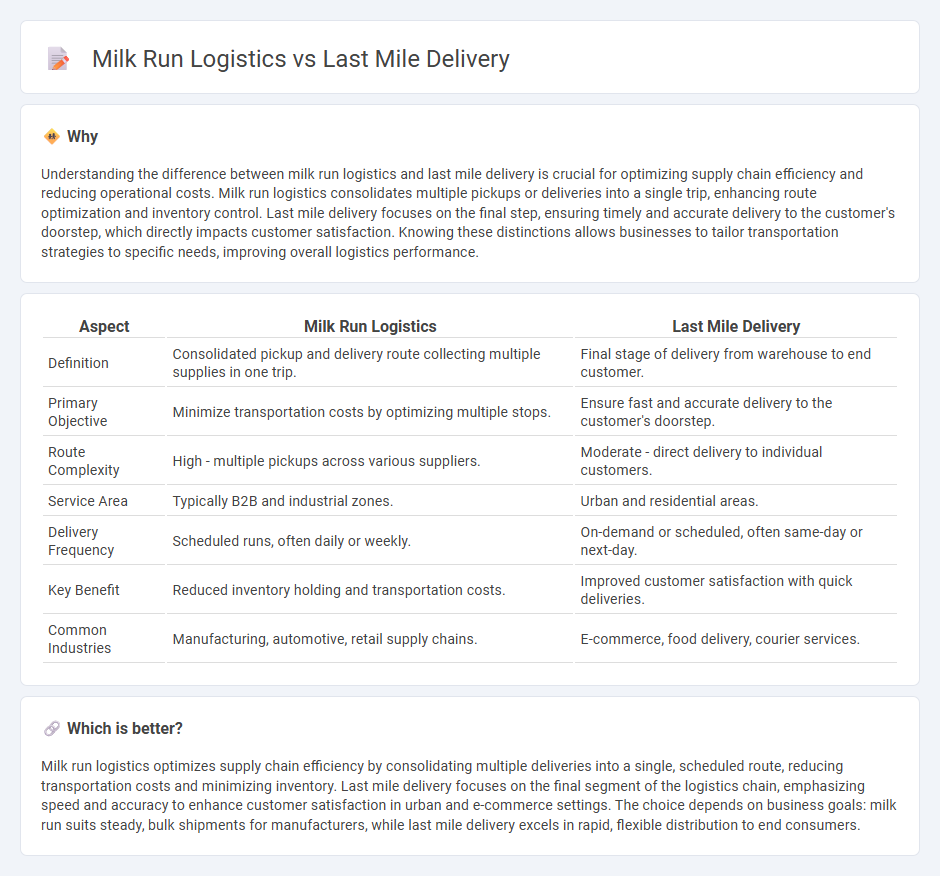
Milk run logistics involves a consolidated transportation method where multiple pickups and deliveries are efficiently combined into a single route, reducing transportation costs and minimizing environmental impact. Last mile delivery focuses on the final step of the supply chain, ensuring that goods reach the customer's doorstep quickly and reliably, often leveraging advanced tracking and routing technologies. Explore how these logistics approaches optimize supply chains and improve customer satisfaction.
Why it is important
Understanding the difference between milk run logistics and last mile delivery is crucial for optimizing supply chain efficiency and reducing operational costs. Milk run logistics consolidates multiple pickups or deliveries into a single trip, enhancing route optimization and inventory control. Last mile delivery focuses on the final step, ensuring timely and accurate delivery to the customer's doorstep, which directly impacts customer satisfaction. Knowing these distinctions allows businesses to tailor transportation strategies to specific needs, improving overall logistics performance.
Comparison Table
| Aspect | Milk Run Logistics | Last Mile Delivery |
|---|---|---|
| Definition | Consolidated pickup and delivery route collecting multiple supplies in one trip. | Final stage of delivery from warehouse to end customer. |
| Primary Objective | Minimize transportation costs by optimizing multiple stops. | Ensure fast and accurate delivery to the customer's doorstep. |
| Route Complexity | High - multiple pickups across various suppliers. | Moderate - direct delivery to individual customers. |
| Service Area | Typically B2B and industrial zones. | Urban and residential areas. |
| Delivery Frequency | Scheduled runs, often daily or weekly. | On-demand or scheduled, often same-day or next-day. |
| Key Benefit | Reduced inventory holding and transportation costs. | Improved customer satisfaction with quick deliveries. |
| Common Industries | Manufacturing, automotive, retail supply chains. | E-commerce, food delivery, courier services. |
Which is better?
Milk run logistics optimizes supply chain efficiency by consolidating multiple deliveries into a single, scheduled route, reducing transportation costs and minimizing inventory. Last mile delivery focuses on the final segment of the logistics chain, emphasizing speed and accuracy to enhance customer satisfaction in urban and e-commerce settings. The choice depends on business goals: milk run suits steady, bulk shipments for manufacturers, while last mile delivery excels in rapid, flexible distribution to end consumers.
Connection
Milk run logistics streamlines supply chain operations by consolidating shipments from multiple suppliers into a single, efficient route, reducing transportation costs and delivery times. Last mile delivery focuses on the final step of the logistics process, ensuring timely and accurate delivery to the end customer, often in urban or densely populated areas. Integrating milk run logistics with last mile delivery optimizes route planning and load management, enhancing overall supply chain efficiency and customer satisfaction.
Key Terms
**Last Mile Delivery:**
Last mile delivery optimizes the final stage of the supply chain by ensuring fast and efficient transport of goods from distribution centers to customers, enhancing customer satisfaction and reducing delivery times. Key components include route optimization, real-time tracking, and the use of electric or autonomous vehicles to lower costs and environmental impact. Discover how last mile delivery transforms e-commerce and urban logistics by improving service quality and operational efficiency.
Route Optimization
Last mile delivery optimizes routes to ensure faster and cost-effective parcel drop-offs, using dynamic routing algorithms and real-time traffic data to minimize delays and fuel consumption. Milk run logistics focuses on predetermined circuit routes for consolidated deliveries, streamlining supply chain efficiency through fixed schedules and reduced transport redundancy. Explore deeper insights into route optimization techniques driving both delivery models for enhanced logistics performance.
Customer Experience
Last mile delivery prioritizes rapid, flexible shipments directly to customers, enhancing satisfaction through real-time tracking and precise delivery windows. Milk run logistics optimizes the supply chain by consolidating shipments from multiple suppliers, reducing costs and environmental impact but offering less immediate customer interaction. Explore how these strategies impact customer experience to optimize your logistics approach.
Source and External Links
Last mile delivery: solutions for your business | DHL Discover - Last mile delivery is the final stage of moving goods from a local distribution center to the end consumer, focusing on affordability, speed, and accuracy through various transport modes and emerging technologies like drones, with customer expectations emphasizing rapid delivery, reliability, and traceability.
Last Mile Delivery Logistics, Trends and Data for Retailers Explained - Last mile delivery is the most costly and time-consuming segment of shipping that significantly impacts customer satisfaction by providing faster delivery and convenience, boosting sales, and enhancing operational efficiency through automation and new supply chain models.
What is Last Mile Delivery? Everything You Need to Know - Onfleet - Last mile delivery describes the critical last step of the shipping process from a transportation hub to the final destination, involving digital order tracking, strategic parcel assignment by route, and requiring optimization to meet growing consumer demand for swift and reliable service.
 dowidth.com
dowidth.com